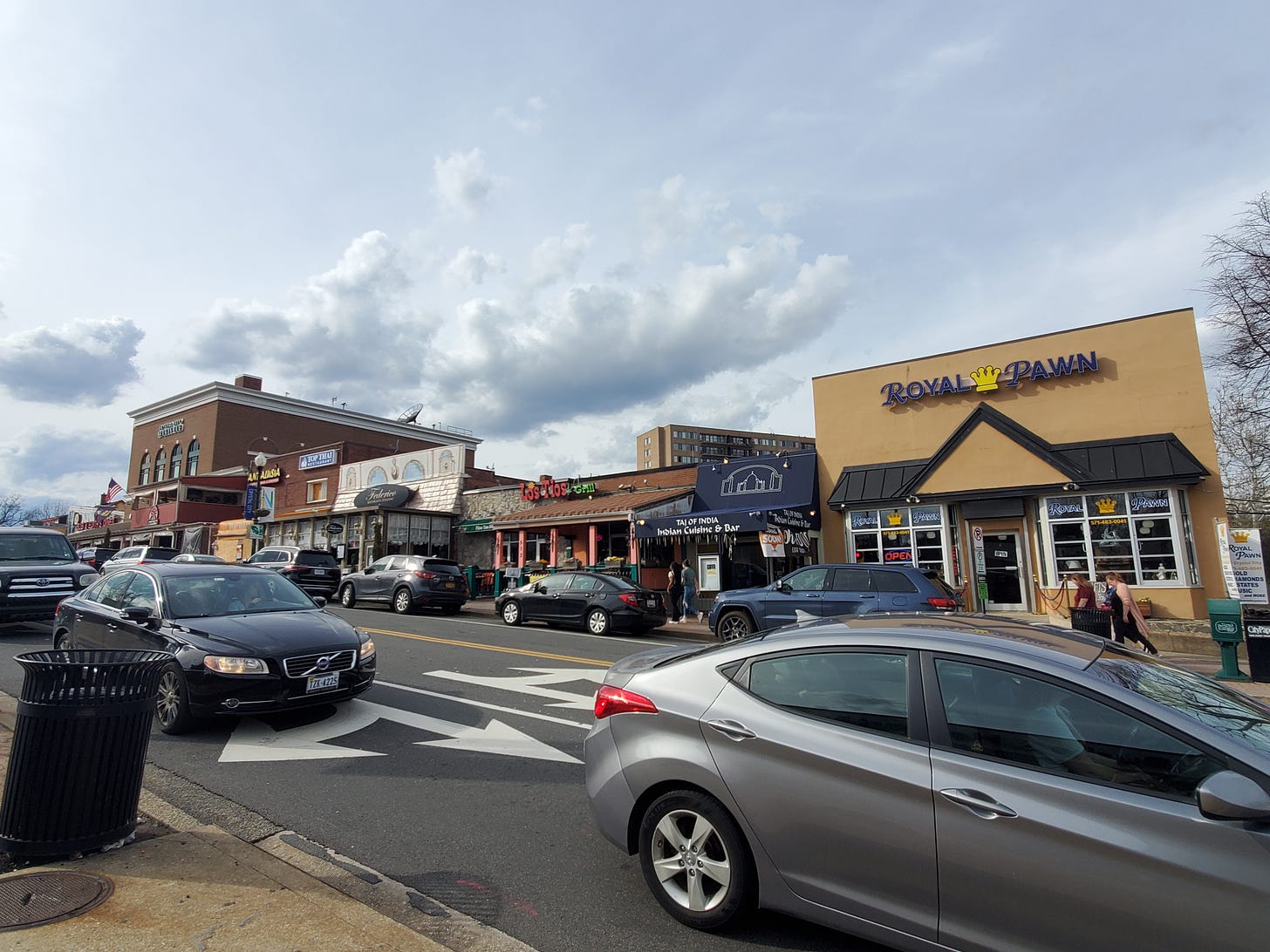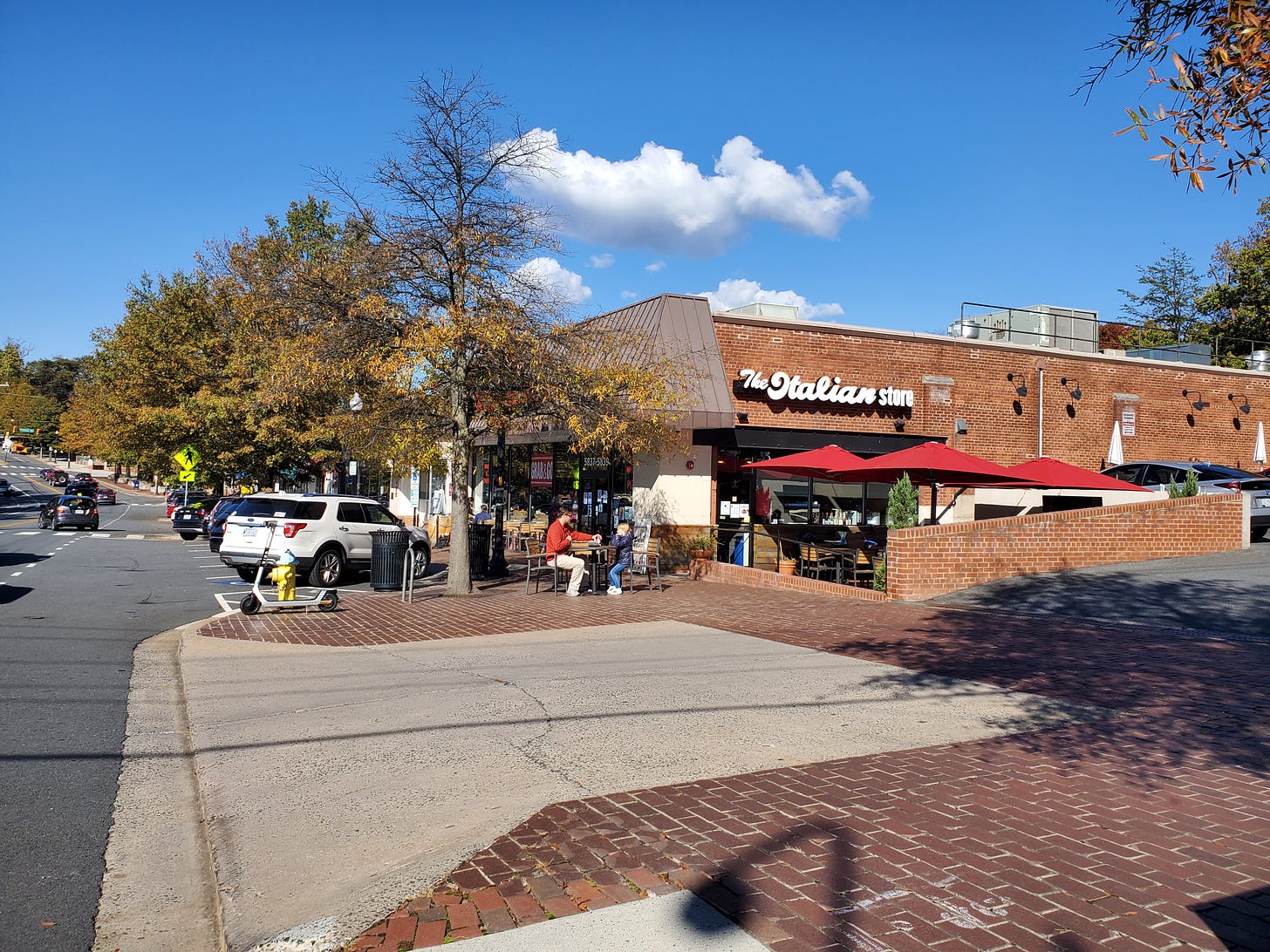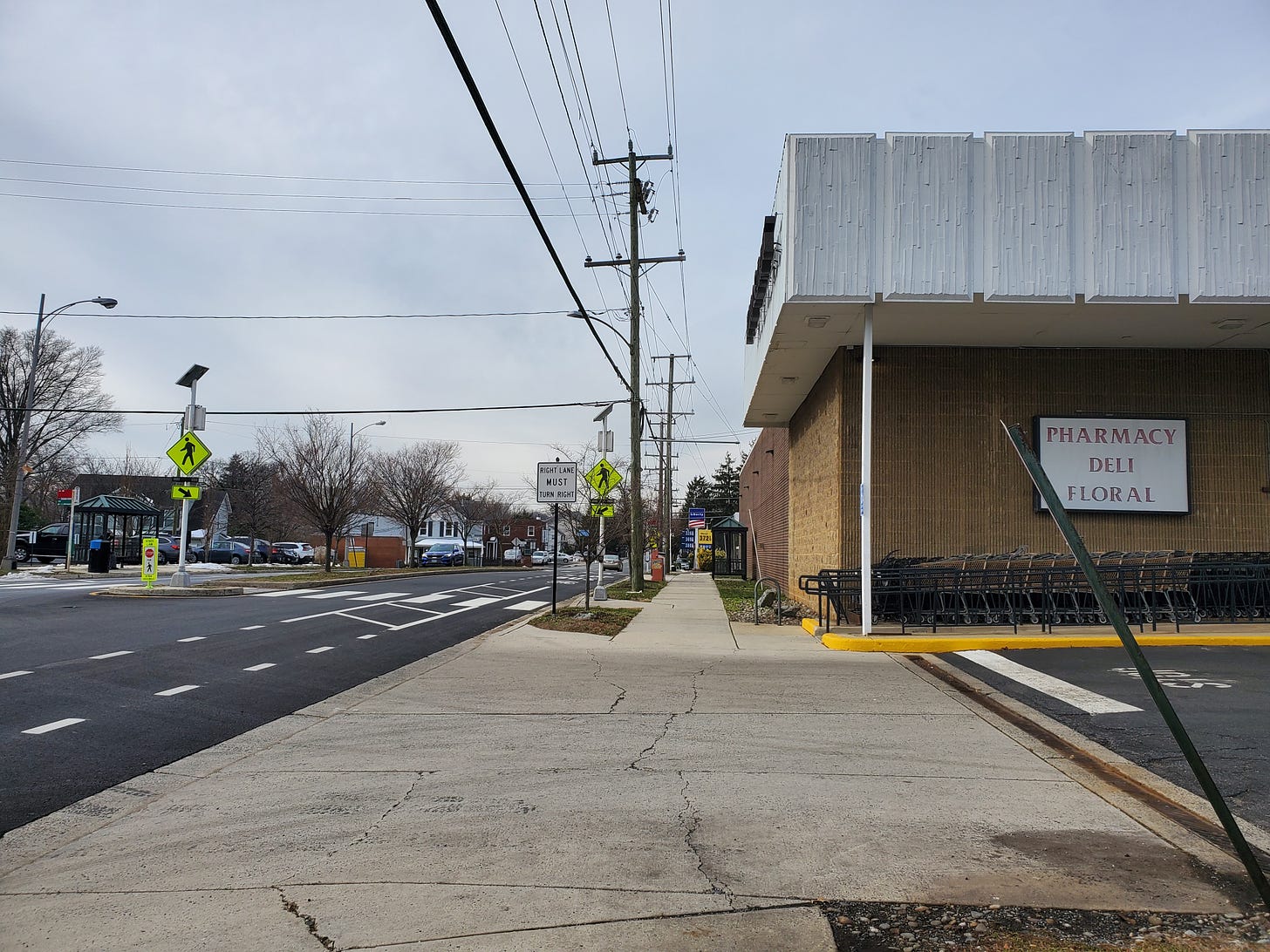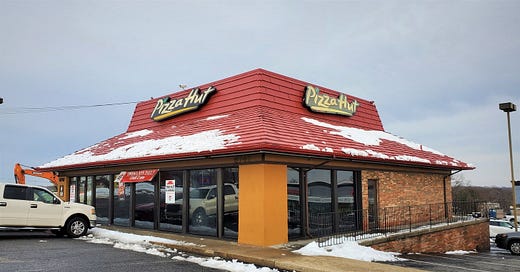
Is It Fair To Redevelop The Best Suburbs?
An interesting question of the possible versus the ideal
You’re simply the first, better than all the worst:
These are some various older neighborhoods in Arlington County, Virginia. They’re a mix of modest single-family homes on small lots on streets in a rough grid design, commercial strips and early big-box stores with smaller parking lots, and some multifamily buildings, many on the smaller side. These are relatively dense, quasi-urban early suburbs.
In a lot of ways, you could argue that this is suburbia at its best. It’s certainly better from an urban-design perspective than the exurbs being built out at the edges of the Sunbelt metros, or a lot of McMansion suburbia from the last few decades, with homes on winding streets completely separated from everything else and pretty much completely dependent on car travel to get anywhere. These older suburbs have some inherent walkability, they can support at least some transit, and they’re also reasonably pleasant to drive around in.
Partly because of this quasi-urban design, and partly because such places tend to be proximate to the urban core, communities like this are very expensive—often far more so than they look like they should be. Because of this—high prices, proximity to the city and urban job market, and a predominance of older buildings where redevelopment can start to make sense—places like this face immense pressure to liberalize their zoning and build more, denser housing. Arlington and neighboring Alexandria were ground zero in debates over and proposals for “missing middle” zoning reform bills, both of which ended up tied up in litigation.
My conceptual question here is, is that fair? Does it make sense? If these are the “best” suburbs from an urbanist perspective—true sub-urbs: outlying communities with a real connection to the city and an element of genuine urban design at a quieter, less intense scale—haven’t they done their duty? Why should these places, with their own history, character, organic and incremental growth over many decades, be disrupted when there are immensely “worse” suburban communities further out to densify?
Another way to put this is, is it wise to focus on further urbanizing/densifying places that are already more in line with what urbanists and housing advocates want than probably 90 percent of American communities?
I’m entertaining here the opposite argument I usually make. Here’s a longer bit on this from a previous piece:
I’ll start with a woman who lived out in the Fredericksburg area, in Stafford County, which is growing rapidly in a dense but almost completely car-dependent pattern: apartments, townhouses, detached houses very close together but not near anything. There’s no incrementalism here: these places go from country/semi-rural to dense suburbia overnight. Fredericksburg is about a one-hour drive from Washington, D.C., no traffic. And there’s never no traffic.
“They’re building these big apartment buildings in the middle of nowhere on country roads,” she said—more than 20 recent large housing developments, by her count. “It doesn’t make any sense.”
Now, given the incentives and constraints that builders and residents face, it does make a kind of sense. But it certainly doesn’t make sense in theory. Nobody thinks it’s ideal. It isn’t designed. It makes sense in the way that the platypus makes sense.
That feeling, that question—why are they putting these big apartment buildings here in the middle of nowhere?—that’s the little crack where the conspiracy theorists stick the crowbar and start prying. That’s the origin of ideas like “Barack Obama instructed HUD to identify nice suburbs to ruin with affordable housing for undeserving poor people.”
I think you have to understand a lot of older folks in these semi-rural communities look at these 5-over-1 apartment buildings sprouting up the same way we’d look at an alien ship landing in a cornfield. It’s completely foreign to their understanding of how people want to live. They are often unaware that this is a symptom of a housing crunch in other places closer to the city. It’s like the shrapnel thrown from an explosion. They don’t see the explosion, and they wonder if they’re being targeted with the shrapnel. (That’s just an analogy; building housing isn’t like bombing a community!)
The point is that I basically think NIMBYism in these outer communities is somewhere between defensible and actually correct. I don’t think these are good places to warehouse people, away from everything because the places with everything want everything but more people. Those places are the expensive, underbuilt inner suburbs in Arlington and Alexandria and the analogous communities in Maryland. Places that were built in a very different era and whose land use no longer matches what the region has grown into.
I guess what I’m saying here is, maybe it’s the middle suburbs—not the semi-urban communities at the city’s edge, not the real towns and country roads way at the edge of the metro area—that should add the most housing. They are the purest example of the contradiction of suburbia: wanting the amenities of urbanity and density without its perceived, imagined, or, in some cases real, costs.
I still think in reality it makes sense that the closer a community is to a population center, and the higher its prices have risen, the more it should add housing. Aside from any judgment of fairness, that’s what the market is telling us. That’s where the demand is. But what do you think of the consideration that the built form of these places is kind of good, and that to some extent it’s a shame that the burden of redevelopment should fall disproportionately on them?
Related Reading:
What If Suburbia Still Looked Like This?
Thank you for reading! Please consider upgrading to a paid subscription to help support this newsletter. You’ll get a weekly subscribers-only piece, plus full access to the archive: over 1,100 pieces and growing. And you’ll help ensure more like this!


















Answering this question is a big part of a planner's job, but to the premise of the question, the answer depends on whether you see the additional density or urbanization as a punishment or a reward. The real world answer will also heavily depend on context, like where the major job centres or transportation links are.
In the absence of this context and speaking in general, my own view is that the older semi-urban suburb will generally be the better one to urbanize, but not because it's likely to be closer to the centre city - it's because its better bones make it more receptive (in a technical sense) to density. The importance of the street pattern can't be overstated, and even a semi-grid network will be far easier to add density to and incorporate additional connections if necessary. On a dendritic curvilinear network in the suburbs, you get far more odd-shaped lots that have a hard time hosting much more than house-type forms (especially under our North American building codes) and street networks with offset street rights-of-way and property lines where connections are harder and less efficient to make. In a street network like this, even with a very high density that could theoretically justify great transit service and a great density of uses that allows for shorter trips, the circuitous routing between most two points means vehicles would remain favoured.
The point about the existing commercial setup is important too: even a strip mall-based main street is likely to be more tied into the existing street network and redevelopable over time. In the power centres serving newer suburbs, not only are they much bigger and more entrenched and therefore difficult to redevelop, but they're often found at the intersection of highways/arterials that isolate them from the rest of the community and which are very hard to retrofit, if even desirable.
The question you pose is an interesting one - what is considered "enough" and "doing your part"? I think, however, there is a fundamental flaw in the warrant of the question (that is, suburbs have a responsibility to densify/not density) that a) assumes opinions to be static and absolute and b) assumes that the current view of suburbs (in this case, Arlington), is "the best," and that the "ideal" is an absolute concept.
In terms of point A, when we pose questions like "this suburb has done enough" or "this suburb has not done enough," we are positing that we (planners, citizens, etc) have a unity of opinions, which they can use to complete control over all the elements of a built space, manipulating them to our will. This view fails to account for both market elements (which I will put aside for now), but also diversity of opinion - what if a resident believes that Arlington as is isn't enough, and wants to see more urban development? What if the first generation believes that Arlington is enough, but the second generation wants to see more TOD? I guess what I am trying to say is that whenever we consider places to be "complete," what we are actually doing is placing our opinion of a place as absolute and concrete, without considering that there are other opinions even within a homogeneous society. The question ends up enforcing the tyranny of the majority, without considering the democracy of opinions that exist in the US (and especially in NoVA, which itself is made up of so many different peoples). Sure, you might want to have a single-family Arlington - but do your kids agree? What if your neighbor wants to add a duplex? Questions of "fairness" arbitrarily decide one viewpoint as correct and inherently morally superior, and thus we have a right to bend a space to our will (or not develop it, as it may be). But that assumes that everyone is of equal mind, and so can agree that it is "fair" or "unfair" to develop a space. What is fair to you might not be fair to another person. What then? This reveals that there is no inherent moral argument in redeveloping it - your opinion is just one among many. Even if you are the majority, the minority opinion exists - and you are still one among many. And you might say then, why move here if you disagree - but then what about the people who were born in Arlington, and want to develop it? Does they opinion matter less because it's not in concordance with the majority? If fairness cannot be achieved in common grounds, because there are too many different versions of fairness - what we have left is: why not then leave people to their own devices, let them devise what is fair/unfair in their own domains? That is the only way to ensure fairness - so that in your plot of land, in your council of one, there is an absolute consensus, and thus an ability to truly adjudicate fairness. Land redevelopment is inherently amoral in that sense - it is not inherently "fair" or "unfair." The fairness comes from the individual person's opinions of what should happen, and how it contrasts to development/a lack of development. That sort of absolute, totalitarian opinion can exist in spaces where you have absolute, totalitarian control, because you can bend it to your will. But it doesn't make sense in spaces with competing or common control, because then you have different ideas of fairness - and thus no definition of fairness at all.
In terms of point B, I would be careful of ascribing a place as "ideal," - we are not God, and we do not know if a place truly is ideal. We think it is good because that's what we are exposed to - but that does not mean there can potentially be better alternatives, and labeling a place as "closed" and "not to be developed further" merely limits us from these better possibilities. How do we know that Arlington won't benefit from being more like Paris, or on the flip side, more like Clifton? We don't. It reminds me a lot of your earlier posts about "what makes NoVA." Growing up here, the only NoVA I know is one that's filled with immigrants - I think this is great! Another example is Eden Center - I love Eden Center. But what if Eden Center was redeveloped to add more housing and better transit? It might lose some of the stores, but it might also end up better in ways we can't predict. Which is truly more "idea" - the small scale, incubator-style urbanism, or the more holistic, but perhaps more sanitized, TOD version? You don't know. But it's very different to the dairy farms that used to exist decades before I was born. Who's to say one is better than another? You can't, of course. But also, who's to say one is more ideal than another? You can't, either. What I am trying to say is that a place can be ideal - but it doesn't preclude the existence of other ideals. And if there are multiple ideals, it means that there are also no ideals - i.e. any of the variations is acceptable. Limiting the current state to "ideal" both is an arrogant assumption of what "ideal" is, and precludes us from finding other ideals that can exist.
In other words, I think the question is inherently flawed, arrogant, and short-sighted. Questions of fairness and ideals don't really make sense for development, in my opinion, because they assign an inherent, absolutist, static totalitarianism into an otherwise dynamic, fluid concept. I'm not a conservative by any stretch of the word, and I'm not sure if we would agree on anything aside from urbanism; but you are one of my favorite urbanists because you engage in the idea of possibilities that is inherent to YIMBYism. Thanks to you, I became convinced of NOVA's uniqueness in its stripmall urbanism (which I used to hate because of its inherent unwalkability, but now appreciate its incubator qualities for immigrant spaces/small-scale, implementable urbanism). And I get the importance of thought exercises, but I would be sad to see you lose some of that inherent, free spirit that permeates your writings.
P.S. I grew up here and don't think Arlington is an ideal suburb at all - I think it's still too car-oriented, not dense enough, not enough transit, and too little infrastructure. For me, an ideal suburb would be something like the inner rings of a place like Chicago or Philly. Do I think personally it's unfair that there are hundreds of NIMBYs blocking any sort of development in that direction? Yes. Do I think I have a right to call this lack of development as a whole/as a concept unfair? No. My opinion, after all, is just one of many.